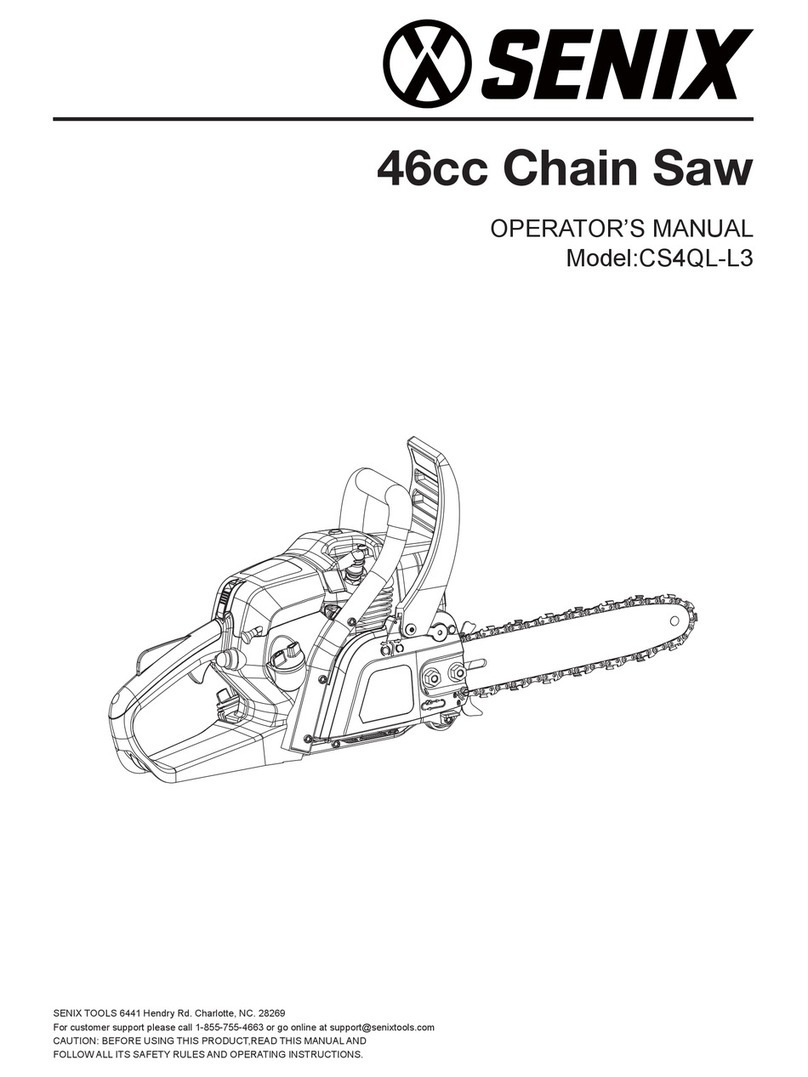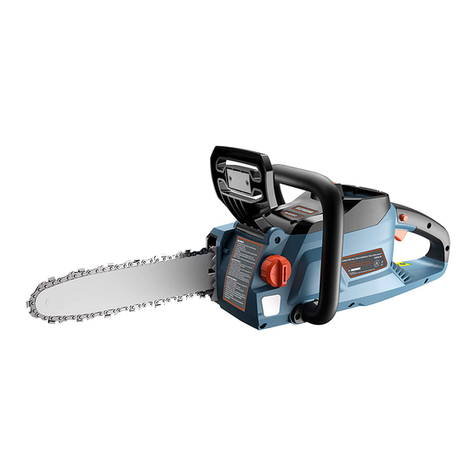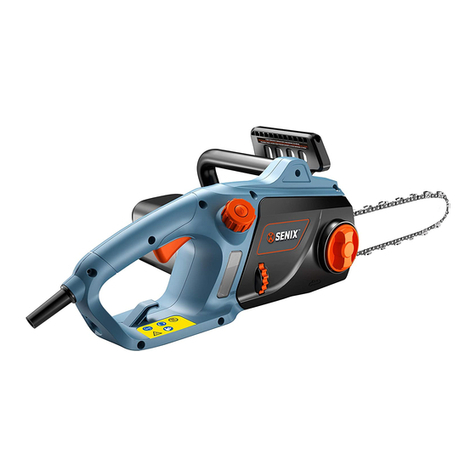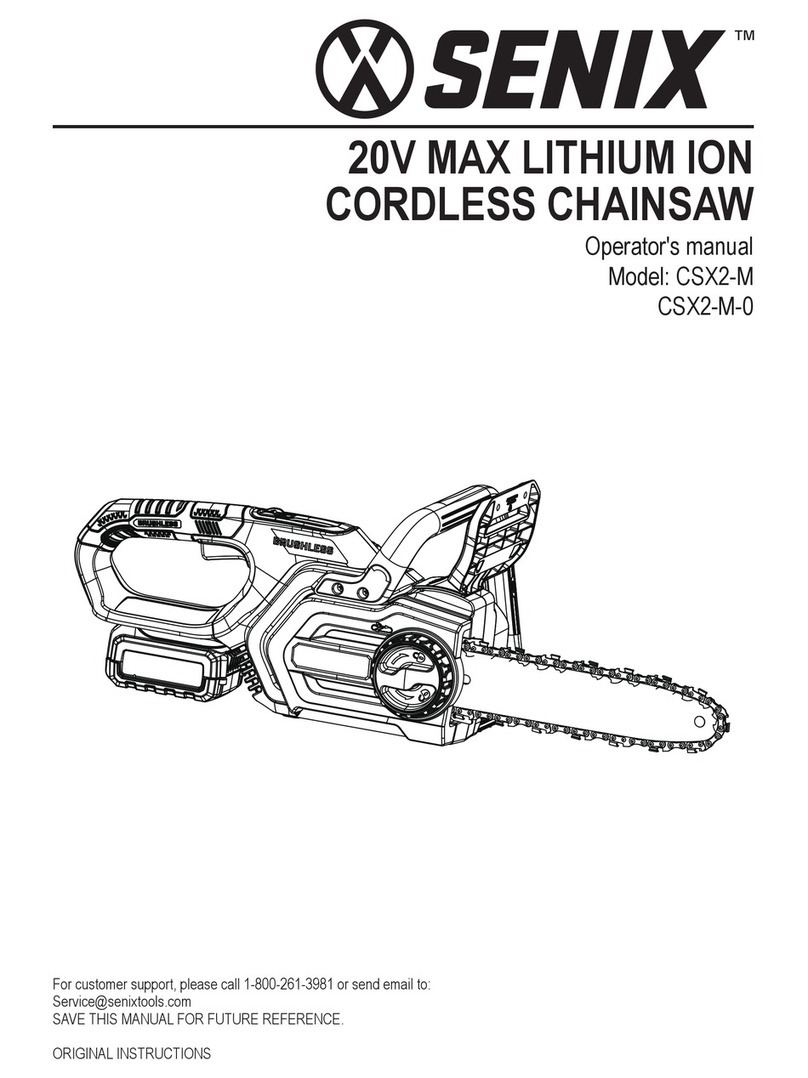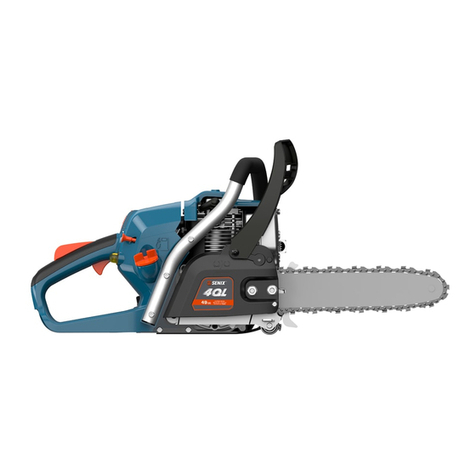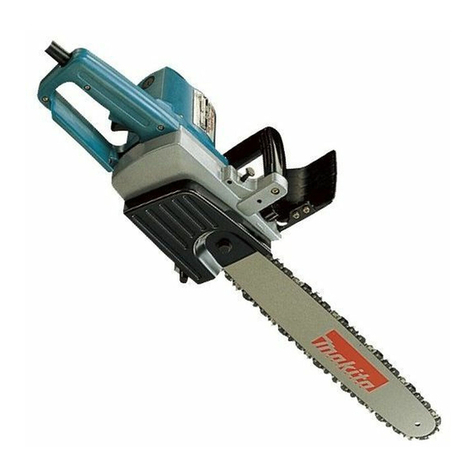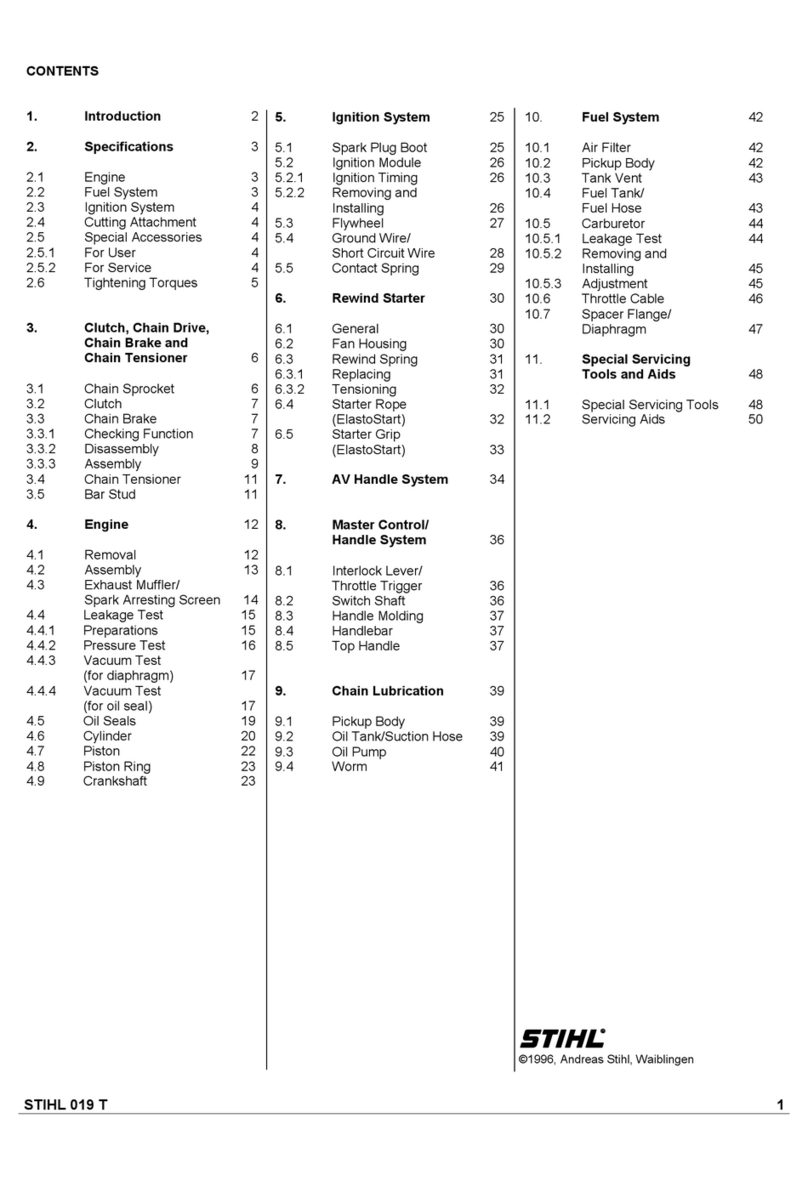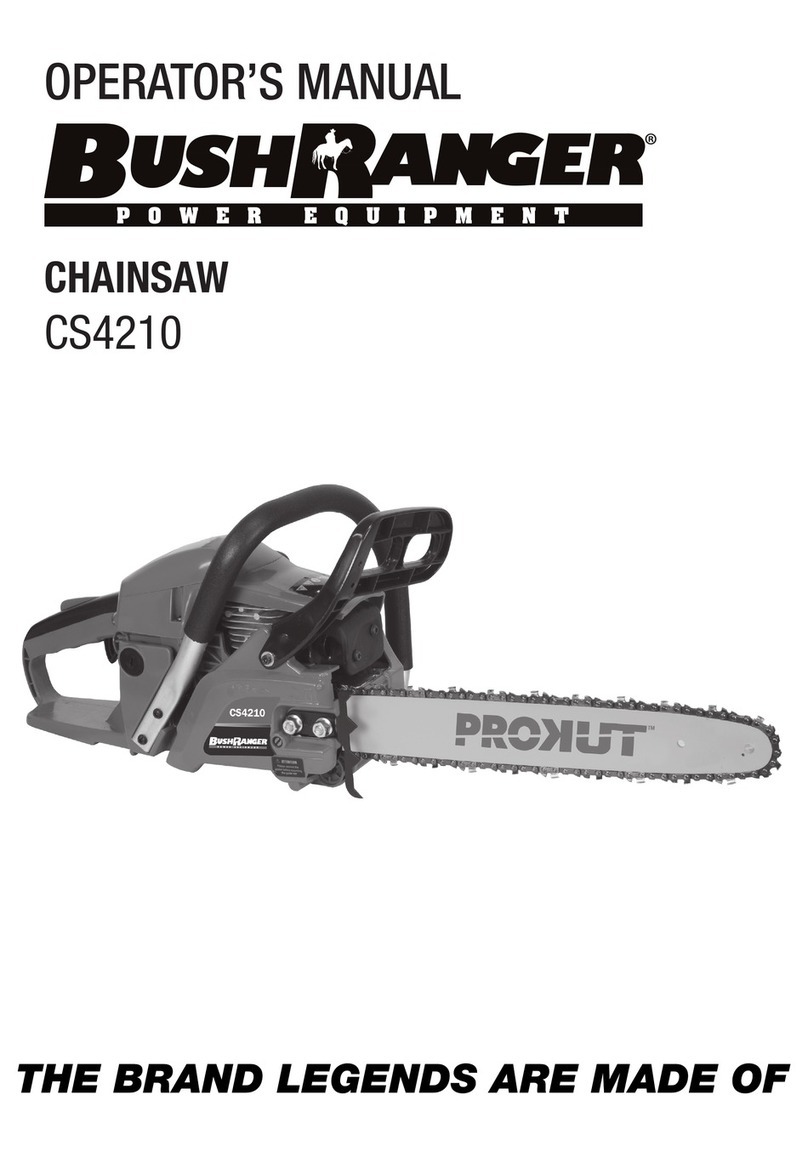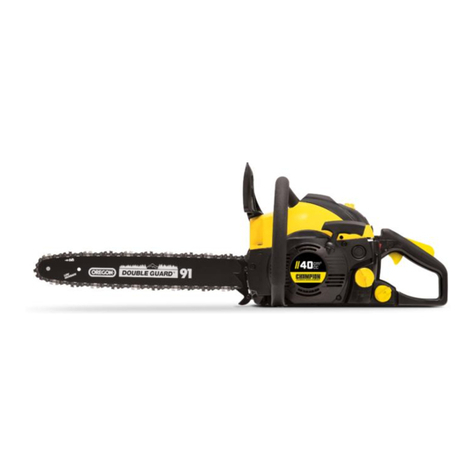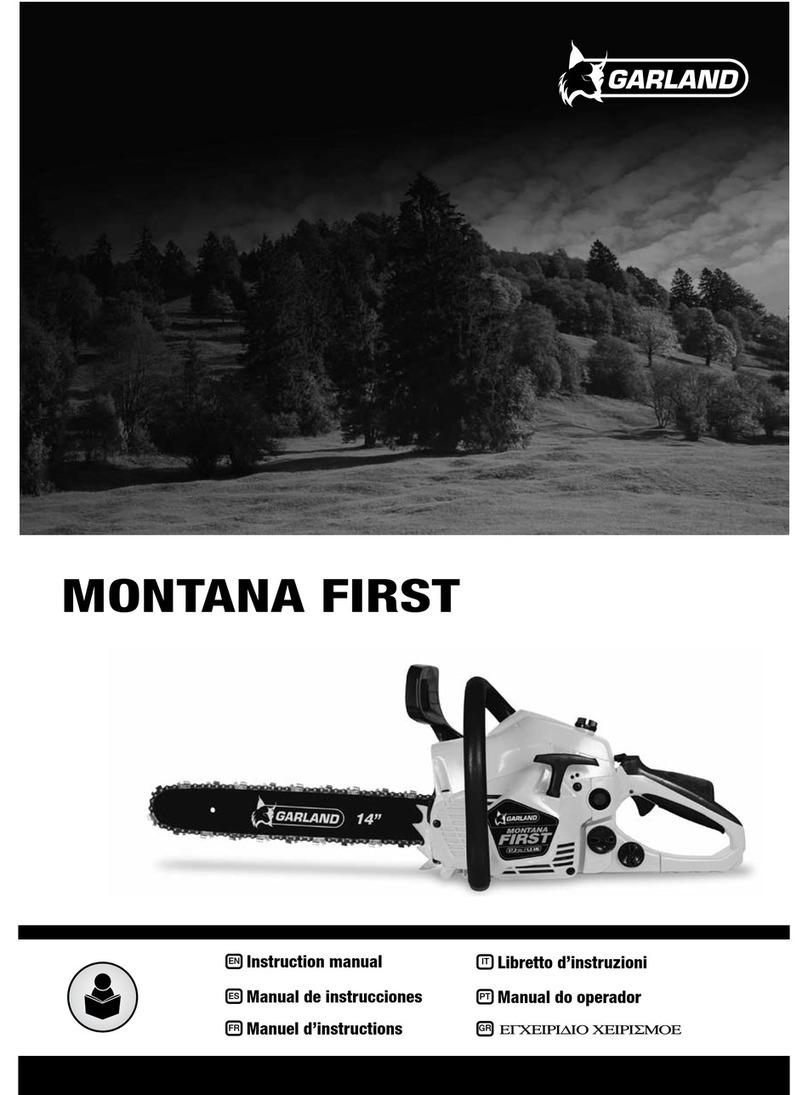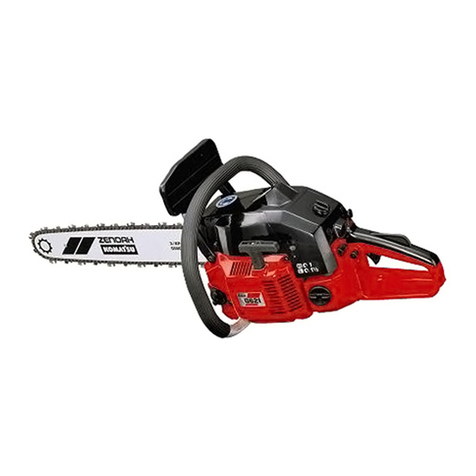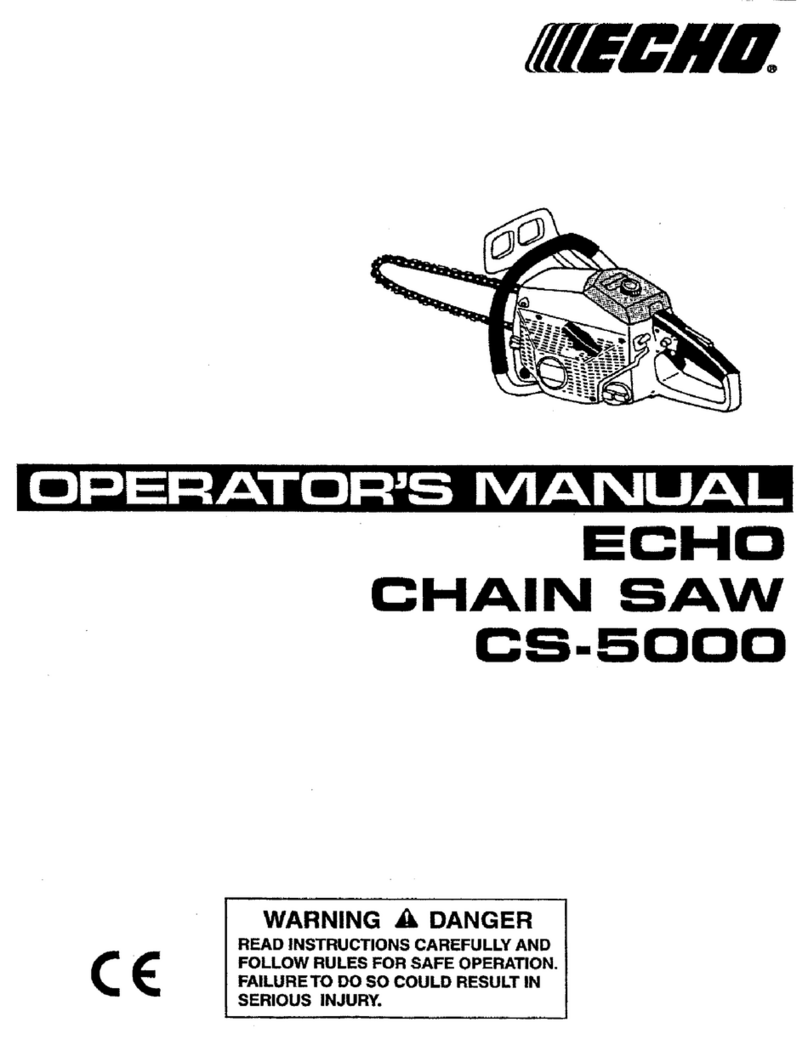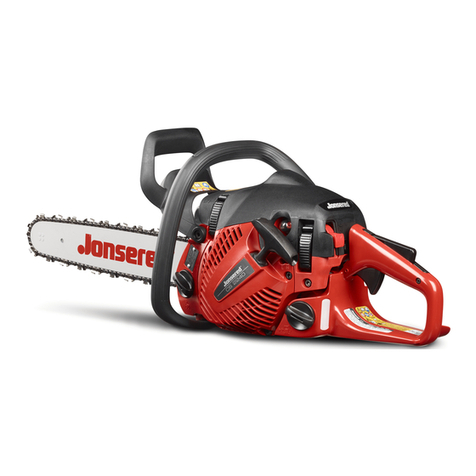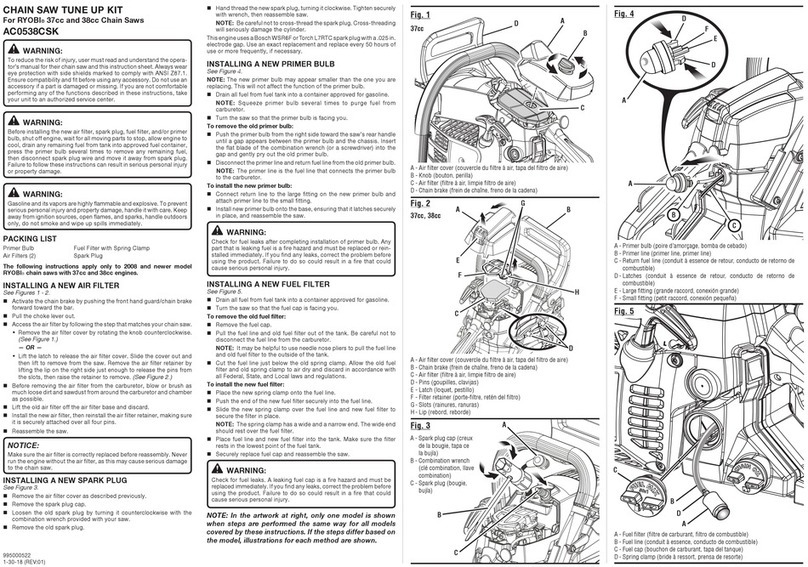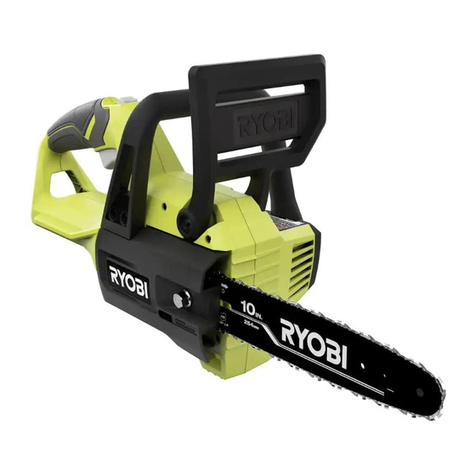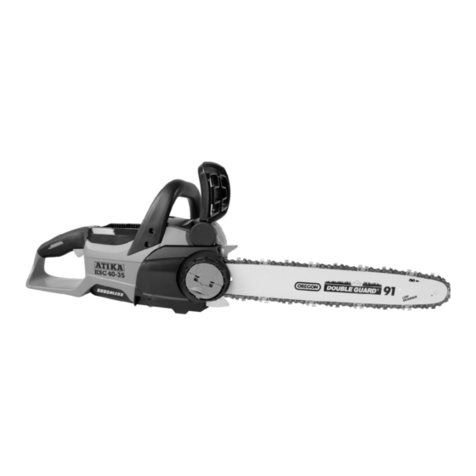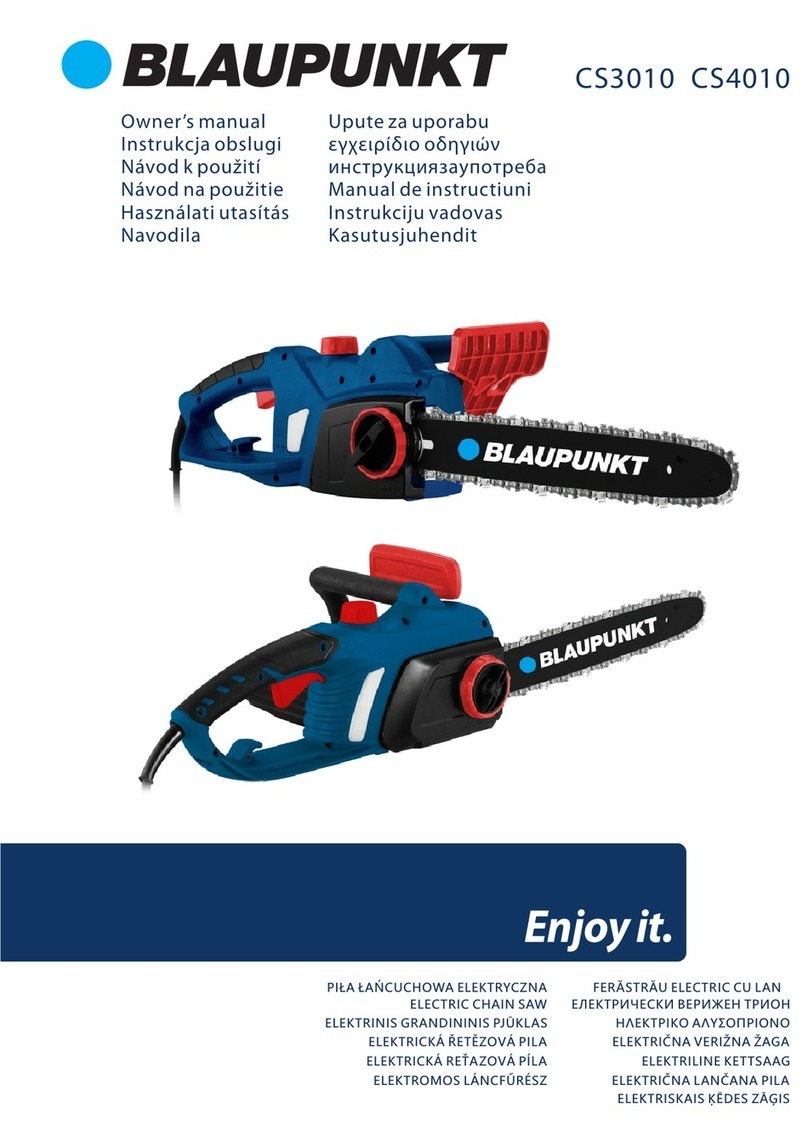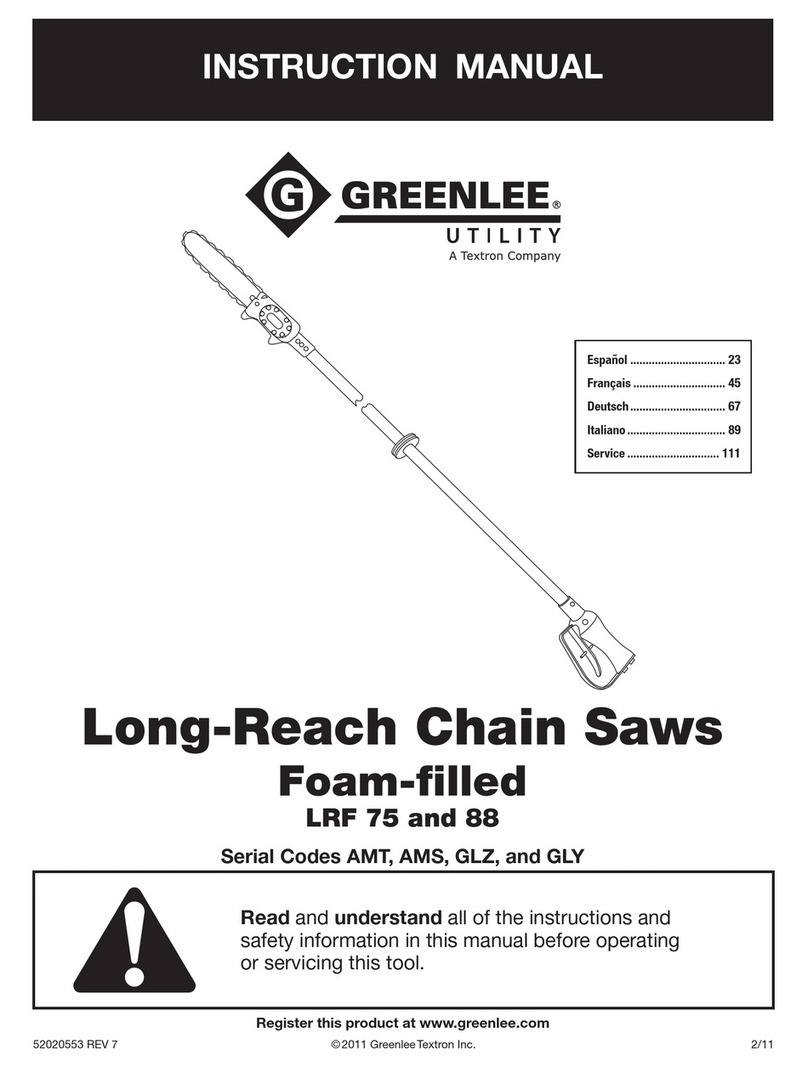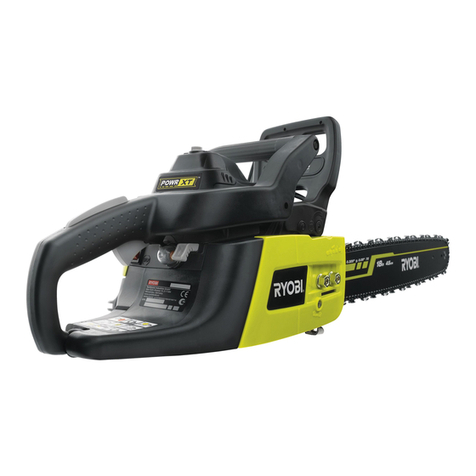Senix CSX2-M1 User manual

20V MAX LITHIUM ION
CORDLESS CHAINSAW
Operator's manual
Model: CSX2-M1
CSX2-M1-0
For customer support, please call 1-800-261-3981 or send email to:
SAVE THIS MANUAL FOR FUTURE REFERENCE.
ORIGINAL INSTRUCTIONS
TM

EN - 2 WWW.SENIXTOOLS.COM
11
12 13 14
8
1
2
4
5
910
6
7
3
1
23

3 - ENWWW.SENIXTOOLS.COM
Drive Sprocket
4
6
98
7
5

EN - 4 WWW.SENIXTOOLS.COM
Trigger Lock-out
Switch Trigger
Danger zone
Escape
route Escape
route
Felling direction
Danger zone
Direction of fall
Notch
50 mm Felling back cut
Hinge
50 mm
Keep work off ground. Leave support limbs until log is cut.
Limb cut
2nd cut overbuck (2/3 diameter)
to meet 1st cut (to avoid pinching)
1st cut underbuck
(1/3 diameter)
to avoid splintering
Log supported one end
Log supported along the entire length
Cut from top (overbuck).Avoid cutting earth.
10 11
12 13
1514

5 - ENWWW.SENIXTOOLS.COM
Bucking a log
Stand on uphill side when cutting because log
may roll
Light Button
2nd cut underbuck (2/3 diameter)
to meet 1st cut (to avoid pinching)
Log supported both ends
1st cut overbuck (1/3 diameter)
to avoid splintering
17
19
16
18

EN - 6 WWW.SENIXTOOLS.COM
TABLE OF CONTENTS
SAFETY & INTERNATIONAL SYMBOLS .......................... 6
SAFETY INSTRUCTIONS.................................................. 7
KNOW YOUR UNIT.......................................................... 15
SPECIFICATIONS* .......................................................... 15
ASSEMBLY ...................................................................... 16
OPERATION..................................................................... 17
MAINTENANCE ............................................................... 20
TROUBLESHOOTING ..................................................... 21
PARTS.............................................................................. 23
WARRANTY..................................................................... 24
SAFETY & INTERNATIONAL
SYMBOLS
Explanation of Safety & international symbols describes
safety and international symbols and pictographs that may
appear on this product. Read the operator’s manual for
complete safety, assembly, operating and maintenance and
repair information.
Caution / Warning.
To reduce the risk of injury, user must read
instruction manual.
Wear eye protection.
Wear hearing protection.
Wear respiratory protection.
Wear protective gloves.
Do not expose to rain.
DANGER – Keep hands away from blade.
Avoid power lines, use in dry conditions.
Keep all bystanders at least 50 ft. away.
Thrown objects can ricochet and result in
personal injury or property damage.
Contact of the guide bar tip with any object
should be avoided.
Tip contact can cause the guide bar to to
move suddenly upward and backward,which
can cause serious injury.
Always use two hands when operating the
chain saw.
Do not dispose of battery packs in rivers or
immerse in water.
Do not dispose of battery packs in fire. They
will explode and cause injury.
Use and store the battery within an temperature
below 122°F(50°C).
Do not disassemble, crush, heat above
212°F(100°C); Never expose the battery to
microwaves or high pressures.

7 - ENWWW.SENIXTOOLS.COM
SAFETY INSTRUCTIONS
GENERAL POWER TOOL SAFETY
WARNINGS
WARNING!
Read all safety warnings and all
instructions. Failure to follow the
warnings and instructions may result
in electric shock, fire and/or serious
injury.
Save all warnings and
instructions for future reference.
The term “power tool” in the
warnings refers to your mains-
operated (corded) power tool or
battery-operated (cordless) power
tool.
1) Work Area Safety
a. Keep work area clean and well
lit. Cluttered or dark areas invite
accidents.
b. Do not operate power tools
in explosive atmospheres,
such as in the presence of
flammable liquids, gases or
dust. Power tools create sparks
which may ignite the dust or
fumes.
c. Keep children and bystanders
away while operating a power
tool. Distractions can cause you
to lose control.
2) Electrical Safety
a. Power tool plugs must match
the outlet. Never modify
the plug in any way. Do not
use any adapter plugs with
earthed (grounded) power tools.
Unmodified plugs and matching
outlets will reduce risk of electric
shock.
b. Avoid body contact with
earthed or grounded surfaces,
such as pipes, radiators,
ranges and refrigerators.
There is an increased risk of
electric shock if your body is
earthed or grounded.
c. Do not expose power tools
to rain or wet conditions.
Water entering a power tool
will increase the risk of electric
shock.
d. Do not abuse the cord. Never
use the cord for carrying,
pulling or unplugging the
power tool. Keep cord away
from heat, oil, sharp edges
or moving parts. Damaged or
entangled cords increase the
risk of electric shock.
e. When operating a power tool
outdoors, use an extension
cord suitable for outdoor
use. Use of a cord suitable for
outdoor use reduces the risk of

EN - 8 WWW.SENIXTOOLS.COM
energising power tools that have
the switch on invites accidents.
d. Remove any adjusting key
or wrench before turning the
power tool on. A wrench or a
key left attached to a rotating
part of the power tool may result
in personal injury.
e. Do not overreach. Keep
proper footing and balance at
all times. This enables better
control of the power tool in
unexpected situations.
f. Dress properly. Do not wear
loose clothing or jewelry.
Keep your hair, clothing and
gloves away from moving
parts. Loose clothes, jewellery
or long hair can be caught in
moving parts.
g. If devices are provided for the
connection of dust extraction
and collection facilities,
ensure these are connected
and properly used. Use of
dust collection can reduce dust-
related hazards.
4) Power Tool Use And Care
a. Do not force the power tool.
Use the correct power tool for
your application. The correct
power tool will do the job better
and safer at the rate for which it
electric shock.
f. If operating a power tool in a
damp location is unavoidable,
use a residual current device
(RCD) protected supply. Use
of an RCD reduces the risk of
electric shock.
3) Personal Safety
a. Stay alert, watch what you
are doing and use common
sense when operating a power
tool. Do not use a power tool
while you are tired or under
the influence of drugs, alcohol
or medication. A moment of
inattention while operating
power tools may result in serious
personal injury.
b. Use personal protective
equipment. Always wear
eye protection. Protective
equipment such as dust mask,
non-skid safety shoes, hard
hat, or hearing protection used
for appropriate conditions will
reduce personal injuries.
c. Prevent unintentional starting.
Ensure the switch is in the off-
position before connecting to
power source and/or battery
pack, picking up or carrying
the tool. Carrying power tools
with your finger on the switch or

9 - ENWWW.SENIXTOOLS.COM
was designed.
b. Do not use the power tool if
the switch does not turn it on
and off. Any power tool that
cannot be controlled with the
switch is dangerous and must be
repaired.
c. Disconnect the plug from
the power source and/or
the battery pack from the
power tool before making
any adjustments, changing
accessories, or storing
power tools. Such preventive
safety measures reduce the
risk of starting the power tool
accidentally.
d. Store idle power tools out of
the reach of children and do
not allow persons unfamiliar
with the power tool or these
instructions to operate the
power tool. Power tools are
dangerous in the hands of
untrained users.
e. Maintain power tools. Check
for misalignment or binding
of moving parts, breakage of
parts and any other condition
that may affect the power
tools operation. If damaged,
have the power tool repaired
before use. Many accidents are
caused by poorly maintained
power tools.
f. Keep cutting tools sharp and
clean. Properly maintained
cutting tools with sharp cutting
edges are less likely to bind and
are easier to control.
g. Use the power tool and any
accessories in accordance
with these instructions, taking
into account the working
conditions and the work to be
performed. Use of the power
tool for operations different from
those intended could result in a
hazardous situation.
5) Battery Tool Use And Care
a. Recharge only with the
charger specified by the
manufacturer. A charger that is
suitable for one type of battery
pack may create a risk of fire
when used with another battery
pack.
b. Use power tools only with
specifically designated battery
packs. Use of any other battery
packs may create a risk of injury
and fire.
c. When battery pack is not in
use, keep it away from other
metal objects, like paper clips,
coins, keys, nails, screws or
other small metal objects,

EN - 10 WWW.SENIXTOOLS.COM
• Always hold the chain saw
with your right hand on the
rear handle and your left hand
on the front handle. Holding
the chain saw with a reversed
hand configuration increases
the risk of personal injury and
should never be done. NOTE:
For chain saws designed with
the guide bar on the left side,
the reference to “right hand”
and “left hand” positioning is
reversed.
• Hold the power tool by
insulated gripping surfaces
only, because the saw
chain may contact hidden
wiring. Saw chains contacting
a″live″wire may make exposed
metal parts of the power tool
″live″and could give the operator
an electric shock.
• Wear safety glasses and
hearing protection. Further
protective equipment for
head, hands, legs and feet
is recommended. Adequate
protective clothing will reduce
personal injury by flying debris
or accidental contact with the
saw chain.
• Do not operate a chain saw in
a tree. Operation of a chain saw
while up in a tree may result in
that can make a connection
from one terminal to another.
Shorting the battery terminals
together may cause burns or a
fire.
d. Under abusive conditions,
liquid may be ejected from
the battery; avoid contact.
If contact accidentally occurs,
flush with water. If liquid contacts
eyes, additionally seek medical
help. Liquid ejected from the
battery may cause irritation or
burns.
6) Service
a. Have your power tool
serviced by a qualified repair
person using only identical
replacement parts. This will
ensure that the safety of the
power tool is maintained.
CHAIN SAW SAFETY WARNINGS
• Keep all parts of the body
away from the saw chain
when the chain saw is
operating. Before you start the
chain saw, make sure the saw
chain is not contacting anything.
A moment of inattention while
operating chain saws may cause
entanglement of your clothing or
body with the saw chain.

11 - ENWWW.SENIXTOOLS.COM
personal injury.
• Always keep proper footing
and operate the chain saw
only when standing on fixed,
secure and level surface.
Slippery or unstable surfaces
such as ladders may cause a
loss of balance or control of the
chain saw.
• When cutting a limb that is
under tension be alert for
spring back. When the tension
in the wood fibres is released
the spring loaded limb may
strike the operator and/or throw
the chain saw out of control.
• Use extreme caution when
cutting brush and saplings.
The slender material may catch
the saw chain and be whipped
toward you or pull you off
balance.
• Carry the chain saw by
the front handle with the
chain saw switched off and
away from your body. When
transporting or storing the
chain saw always fit the guide
bar cover. Proper handling of
the chain saw will reduce the
likelihood of accidental contact
with the moving saw chain.
• Follow instructions for
lubricating, chain tensioning
and changing accessories.
Improperly tensioned or
lubricated chain may either
break or increase the chance for
kickback.
• Keep handles dry, clean, and
free from oil and grease.
Greasy, oily handles are slippery
causing loss of control.
• Cut wood only. Do not use
chain saw for purposes not
intended. For example: do not
use chain saw for cutting plastic,
masonry or non-wood building
materials. Use of the chain
saw for operations different
than intended could result in a
hazardous situation.
CAUSES AND OPERATOR
PREVENTION OF KICKBACK
Kickback may occur when the nose
or tip of the guide bar touches an
object, or when the wood closes in
and pinches the saw chain in the
cut.
Tip contact in some cases may
cause a sudden reverse reaction,
kicking the guide bar up and back
towards the operator.
Pinching the saw chain along the
top of the guide bar may push the
guide bar rapidly back towards the
operator.

EN - 12 WWW.SENIXTOOLS.COM
may cause chain breakage and/
or kickback.
• Follow the manufacturer’s
sharpening and maintenance
instructions for the saw chain.
Decreasing the depth gauge
height can lead to increased
kickback.
VIBRATION AND NOISE
REDUCTION
To reduce the impact of noise and
vibration emission, limit the time of
operation, use low-vibration and low-
noise operating modes as well as
wear personal protective equipment.
Take the following points into
account to minimize the vibration
and noise exposure risks:
• Only use the product as
intended by its design and these
instructions.
• Ensure that the product is
in good condition and well
maintained.
• Use correct attachments for the
product and ensure they are in
good condition.
• Keep tight grip on the handles/
gripping surface.
• Maintain this product in
accordance with these
instructions and keep it well
lubricated (where appropriate).
Either of these reactions may cause
you to lose control of the saw which
could result in serious personal
injury. Do not rely exclusively upon
the safety devices built into your
saw. As a chain saw user, you
should take several steps to keep
your cutting jobs free from accident
or injury.
Kickback is the result of tool
misuse and/or incorrect operating
procedures or conditions and
can be avoided by taking proper
precautions as given below:
• Maintain a firm grip, with
thumbs and fingers encircling
the chain saw handles, with
both hands on the saw and
position your body and arm to
allow you to resist kickback
forces. Kickback forces can
be controlled by the operator, if
proper precautions are taken.
Do not let go of the chain saw.
• Do not overreach and do not
cut above shoulder height.
This helps prevent unintended
tip contact and enables better
control of the chain saw in
unexpected situations.
• Only use replacement bars
and chains specified by
the manufacturer. Incorrect
replacement bars and chains

13 - ENWWW.SENIXTOOLS.COM
• Plan your work schedule to
spread any high vibration tool
use across a longer period of
time.
• Prolonged use of the product
exposes the user to vibrations
that can cause a range of
conditions collectively known as
hand-arm vibration syndrome
(HAVS) e.g. fingers going white;
as well as specific diseases
such as carpal tunnel syndrome.
• To reduce this risk when using
the product, always wear
protective gloves and keep your
hands warm.
• The symptoms of HAVS include
any combination of the following:
Tingling and numbness in the
fingers; Not being able to feel
things properly; Loss of strength
in the hands; Fingers going
white (blanching) and becoming
red and painful on recovery
(particularly in the cold and wet,
and probably only in the tips
at first).Seek medical advice
immediately if such symptoms
are experienced.
EMERGENCY
Familiarize yourself with the use
of this product by means of this
instruction manual. Memorize the
safety directions and follow them to
the letter. This will help to prevent
risks and hazards.
• Always be alert when using
this product, so that you can
recognize and handle risks early.
Fast intervention can prevent
serious injury and damage to
property.
• Switch off the product and
remove the battery pack if there
are malfunctions. Have the
product checked by a qualified
professional and repaired, if
necessary, before you operate it
again.
RESIDUAL RISKS
Even if you are operating this
product in accordance with all
the safety requirements, potential
risks of injury and damage remain.
The following dangers can arise in
connection with the structure and
design of this product:
• Health defects resulting from
vibration emission if the product
is being used over long periods
of time or not adequately
managed and properly
maintained.
• Injuries and damage to property
due to broken attachments or
the sudden impact of hidden

EN - 14 WWW.SENIXTOOLS.COM
objects during use.
• Danger of injury and property
damage caused by flying
objects.
• Prolonged use of this product
expose the operator to vibrations
and may produce ‘whitefinger’
disease. In order to reduce the
risk, please wear gloves and
keep your hands warm. If any
of the ‘whitefinger’ symptoms
appear, seek medical advice
immediately. ‘Whitefinger’
symptoms include: numbness,
loss of feeling, tingling, pricking,
pain, loss of strength, changes
in skin colour or condition.
These symptoms normally
appear in the fingers, hands or
wrists. The risk increases at low
temperatures.
WARNING!
This product produces an
electromagnetic field during
operation! This field may under
some circumstances interfere with
active or passive medical implants!
To reduce the risk of serious or fatal
injury, we recommend persons with
medical implants to consult their
doctor and the medical implant
manufacturer before operating this
product!

15 - ENWWW.SENIXTOOLS.COM
KNOW YOUR UNIT
APPLICATIONS
Model: CSX2-M1
As a chainsaw:
Limbing, felling, woodcutting, and remove buttress roots.
1Battery Pack
2Unlock Button of Battery Pack
3Rear Handle
4Trigger Lock-out
5Guard with Chain Brake
6Guide Bar
7Saw Chain
8Guide Bar Cover
9Oil Tank Cap
10 Auxiliary Handle
11 Switch Trigger
12 Side Cover
13 Side Cover Nut
14 Tensioning Gear
NOTE:
CSX2-M1-0 does not include the charger and the battery
pack.
SPECIFICATIONS*
Model CSX2-M1
Rated voltage 18V d.c.
No-load speed 6000rpm
Recommended bar and chain 10inch / 8inch
Guide bar length 10inch
Cutting capacity 22cm
Chain speed 11m/s
Oil capacity 2.05oz
Weight (without battery, saw
chain and guide bar ) 4.19lbs
Battery pack model B25X2 B50X2
Rated voltage 18V 18V
Rated capacity 2.5Ah 5.0Ah
Weight 0.74lbs 1.43lbs
Charger model CHX2
Rated input 100-240V ~ 50/60Hz
Rated output 21V, 2000mA
Charging time
(with 2.5 Ah battery) 85mins
Charging time
(with 5.0 Ah battery) 130mins
Protection class
(for charger) / II
Weight 0.75lbs
Model CSX2-M1-0
Rated voltage 18V d.c.
No-load speed 6000rpm
Length of the guide bar 10inch
Cutting capacity 22cm
Chain speed 11m/s
Oil capacity 2.05oz
Weight (without battery, saw
chain and guide bar ) 4.19lbs
Battery pack model Not included
Charger model Not included

EN - 16 WWW.SENIXTOOLS.COM
ASSEMBLY
1. Unpack all parts and lay them on a flat, stable surface:
2. Remove all packing materials and shipping devices, if
applicable.
3. The scope of delivery varies depending on the country
and purchased variant:
Model of CSX2-M1-0
• Chainsaw x1
• Instruction manual x1
• Guide bar x1
• Guide bar cover x1
• Saw chain x1
• Wrench x1
4. If you find that parts are missing or show damage do
not use the product but contact your dealer. Using an
incomplete or damaged product represents a hazard to
people and property.
5. Ensure that you have all the accessories and tools
needed for assembly and operation. This also includes
suitable personal protective equipment.
NOTE:
CSX2-M1 includes the charger and the battery pack.
CSX2-M1-0 does not include the charger and the battery
pack.
WARNING:
Wear protective gloves for this assembly work
and always lay the product on a flat and stable
surface while assembling.
Follow the assembly instructions step-by-step
and use the pictures provided as a visual guide
to easily assemble the product!
Do not insert the battery pack before the power
tool is completely assembled or adjusted!
INSTALLING THE SAW CHAIN
AND THE GUIDE BAR
WARNING:
Ensure the battery pack is removed from the
chainsaw before attaching the bar and chain.
1. Totally loosen the side cover nut counterclockwise with
the assistance of wrench. Then remove the side cover
(Fig.2).
2. Loop the new saw chain into the slot of the guide bar
according to the provided gure (Fig.3).
3. Install the guide bar and the saw chain on the drive
sprocket (Fig.4). Adjust the tensioning gear when the
guide bar and saw chain can not be mount over the drive
sprocket (Fig.5).
4. Pull the chain around the guide bar with your gloved
hand or using auxiliary tools to make sure it can run
smoothly.
NOTE:
It is still recommended to check for smoothness of the saw
chain before operation even after using it for a period of
time.
5. Replace the side cover and slightly tighten the side
cover nut (Fig.2). Do not tighten too much. Meanwhile,
protect the saw chain from sliding out.
6. Twist the tensioning gear till the saw chain can be lifted
by 2-3 mm from the center of the guide bar.
7. Fully tighten the side cover nut clockwise (Fig.2).
NOTE:
After a short period of use, allow the chain to cool, remove
the battery and check the tension again.
BAR AND CHAIN OIL FILLING
WARNING:
Bar and chain oil prevents premature wear.
Never operate the chainsaw if oil is not visible.
Check oil level frequently and fill as needed.
NOTE:
Bar and chain oil is required to properly lubricate the guide
bar and saw chain. The chainsaw is equipped with an
automatic oiler that deposits oil on the bar and chain when
running, keeping them properly lubricated.
1. Place the chainsaw on its side on a rm, at surface, so
that the oil tank cap is on top.
2. Clean any debris from the cap area.
3. Remove the oil tank cap (Fig.6).
4. Carefully pour the bar and chain oil into the tank.
5. Replace the cap and make sure oil is visible in the tank.
INSTALLING/REMOVING THE
BATTERY PACK
To install:
Slide the battery pack to the battery docking port on the

17 - ENWWW.SENIXTOOLS.COM
product until it clicks (Fig.7).
To remove:
Press the unlock button on the battery pack and slide the
battery pack out.
OPERATION
WARNING:
Never operate a chain saw that is damaged or
improperly adjusted or that is not completely and
securely assembled. Be sure that the saw chain
stops moving when the power control system
trigger is released. Never adjust the guide bar or
saw chain when the engine is operating.
TESTING THE CHAIN BRAKE
This chainsaw is designed with a function of chain brake
on the guard, which stops both the motor and the motion of
the chain when kickback occurs. The chain brake can be
activated by pushing the guard forward as the saw rotates
backward during kickback. Make sure the chain brake is
working before using the chainsaw.
To check brake operation (Fig.8):
• Place the saw on a rm, at surface.
• Start the saw briey.
• Push the guard forward to activate the function of chain
brake. A properly functioning chain brake stops the motor
and saw chain immediately. If the motor and saw chain do
not stop immediately, have the chain brake checked at an
approved service location.
• Release the switch trigger.
• Return to operating position.
PRIMING THE OILER
WARNING:
Keep hands, clothing, and hair away from the
drive sprocket when priming the oiler.
NOTE:
Prime the oiler before the rst use or after being stored for
a long time.
It is essential to ll with oil before use. Operating the
chainsaw without bar and chain oil will result in damage to
the chain saw. The chain is automatically lubricated with oil
during operation via the oil outlet (Fig.9).
1. Insert the battery.
2. Run the chainsaw for about two minutes.
3. Remove the battery.
4. Remove the side cover.
5. Check for oil on the bar.
TENSIONING THE SAW CHAIN
NOTE:
Check the tension between the saw chain and the guide bar
before every starts of the chainsaw.
WARNING:
Only tension the saw chain when the chain is
cool. A hot chain may contract and damage the
guide bar or chain as it cools.
1. It is no need to remove the side cover for adjusting the
chain tensioning gear (Fig.5). Just loosen the side cover
nut slightly by a wrench to unlock the guide bar and saw
chain which completely locked during operation.
2. Twist the tensioning gear till the chain come to a suitable
tension status. The correct chain tension is reached
when the saw chain can be lifted by 2-3 mm from the
center of the chain bar.
3. Tighten the side cover nut after adjustment.
NOTE:
If the chain is still loose when the saw is at maximum
tension, replace the chain.
SWITCHING ON/OFF
WARNING:
Follow the instructions in your operator’s manual
for starting the chain saw and control the chain
saw with a firm grip on both handles when it is in
operation. Always hold the chain saw with your
right hand on the rear handle and your left hand
on the front handle. Keep handles dry, clean,
and free of oil.
Ensure the guard is at operation position. If not, turn it back
to the operation position.
Keep the trigger lock-out being pressed at rst, then
squeeze the switch trigger to start the product. Just release
the trigger lock-out once the chainsaw starts. To turn off the
chainsaw, release the switch trigger (Fig.10).

EN - 18 WWW.SENIXTOOLS.COM
OVERHEAT PROTECTION OF
CHAINSAW
When the temperature of PCB is above 248°F(120°C)
during operation, The chainsaw will be shut down
automatically. Wait it to cool down for about ve minutes
then restart the product.
GENERAL SAWING TECHNIQUES
NOTE:
It is recommended that first-time user should, as a minimum
practice, cutting logs on a saw-horse or cradle.
• Saw off the lower branches on the tree first. By doing so,
it is easier for the cut branches to fall to the ground.
• At the end of the cut, the weight of the saw suddenly
increases for the user since it is no longer being
supported by a branch. There is a risk of losing control
of the saw, so make sure to stay alert during the entire
sawing operation.
• Only pull the saw out of a cut while the saw is running.
By doing so, you prevent the chain from jamming in the
wood.
• DO NOT saw with the tip of the chain bar. DO NOT saw
into the branch formations (where the tree branches
outwards). This will impede the tree’s ability to heal.
• For sawing off smaller branches, place the stop face
of the saw on the branch. This prevents unwanted
movements of the saw at the beginning of the cut. While
applying light pressure, guide the saw through the branch
from top to bottom.
• For sawing off larger branches, first make a relief cut.
Saw through 1/3 of the branch diameter from the bottom
to top using the top side of the chain bar. Then saw from
top to bottom for the other 2/3 using the bottom side of
the chain bar. Saw off longer branches in sections in order
to maintain control over the location of impact.
FELLING A TREE
When cross-cutting/bucking and felling operations are
being performed by two or more persons at the same
time, the felling operations should be separated from the
crosscutting/bucking operation by a distance of at least
twice the height of the tree being felled.
Trees should not be felled in a manner that would endanger
any person, strike any utility line or cause any property
damage. If the tree does make contact with any utility line,
the company should be notied immediately.
The chain saw operator should keep on the uphill side of
the terrain as the tree is likely to roll or slide downhill after
it is felled.
An escape path should be planned and cleared as
necessary before cuts are started. The escape path should
extend back and diagonally to the rear of the expected line
of fall (Fig.11).
Before felling is started, consider the natural lean of the
tree, the location of larger branches and the wind direction
to judge which way the tree will fall.
Remove dirt, stones, loose bark, nails, staples and wire
from the tree.
NOTCHING UNDERCUT
Make the notch 1/3 the diameter of the tree, perpendicular
to the direction of falls (Fig.12). Make the lower horizontal
notching cut rst. This will help to avoid pinching either the
saw chain or the guide bar when the second notch is being
made.
FELLING BACK CUT
Make the felling back cut at least 2inch(50 mm)higher than
the horizontal notching cut (Fig. 12). Keep the felling back
cut parallel to the horizontal notching cut. Make the felling
back cut so enough wood is left to act as a hinge. The hinge
wood keeps the tree from twisting and falling in the wrong
direction. Do not cut through the hinge.
As the felling gets close to the hinge, the tree should begin
to fall. If there is any chance that the tree may not fall in
desired direction or it may rock back and bind the saw
chain, stop cutting before the felling back cut is complete
and use wedges of wood, plastic or aluminium to open the
cut and drop the tree along the desired line of fall.
When the tree begins to fall, remove the chain saw from the
cut, stop the motor, put the chain saw down, then use the
retreat path planned. Be alert for overhead limbs falling and
watch your footing.
LIMBING A TREE
Limbing is removing the branches from a fallen tree. When
limbing leave larger lower limbs to support the log off
the ground. Remove the small limbs in one cut (Fig.13).
Branches under tension should be cut from the bottom up to
avoid binding the chain saw.
CROSS-CUTTING/BUCKING A
LOG
Cross-cutting/bucking is cutting a log into lengths. It is
important to make sure your footing is rm and your weight
is evenly distributed on both feet. When possible, the log
should be raised and supported by the use of limbs, logs or

19 - ENWWW.SENIXTOOLS.COM
chocks. Follow the simple directions for easy cutting.
When the log is supported along its entire length (Fig.14), it
is cut from the top (overbuck).
When the log is supported on one end (Fig.15), cut 1/3 the
diameter from the underside (underbuck). Then make the
nished cut by overbucking to meet the rst cut.
When the log is supported on both ends (Fig.16), cut 1/3
the diameter from the top (overbuck). Then make the
nished cut by underbucking the lower 2/3 to meet the rst
cut.
When cross-cutting/bucking on a slope always stand on the
uphill side of the log (Fig.17).
When “cutting through”, to maintain complete control,
release the cutting pressure near the end of the cut without
relaxing your grip on the chain saw handles.
Don’t let the chain contact the ground. After completing
the cut, wait for the saw chain to stop before you move the
chain saw. Always stop the motor before moving from tree
to tree.
CHARGING THE BATTERY PACK
WARNING:
This Lithium-Ion battery pack is shipped partially
charged. Fully charge the battery pack before
using it for the first time.
NOTE:
Charge batteries at a ambient temperature of 32°F-104°F
(0°C-40°C) and always store batteries at a ambient
temperature of 32°F-77°F (0°C-25°C).
1. Charge the Lithium-Ion battery pack only with the correct
charger.
2. Connect the charger to a power supply, the light indicator
of the charger turns red.
3. Align the raised ribs of the battery pack with the slot in
the charger.
4. Insert the battery pack into the charger, the light indicator
of the charger turns green and it ashes (Fig.18).
5. The charger will communicate with the battery pack to
evaluate the condition of the battery pack.
6. It is fully charged that the four lights of the battery turn
on. Disconnect the power supply from the charger.
Remove battery pack from the charger.
CHARGING INDICATOR
Press the light button on the battery pack to check whether it
needs to charge (Fig.19) .
Lights
Status
Lighted Off Blinking
The battery is at full
capacity.
The battery is at 75%
capacity.
The battery is at 50%
capacity and requires
charging.
The battery is at 25%
capacity and requires
charging soon.
The battery is less
than 5% capacity
and requires charging
immediately.
WARNING:
Malfunctions may occur when the four lights
blinking in turns.
OVERHEAT PROTECTION
When the tool/battery is overheated, the tool stops
automatically. In this situation, let the power tool/battery cool
before turning the tool on again.
OVERDISCHARGE PROTECTION
When the battery capacity is not enough, the tool stops
automatically. In this case, remove the battery from the tool
and charge the battery.

EN - 20 WWW.SENIXTOOLS.COM
MAINTENANCE
WARNING:
Failure to identify and replace damaged or worn
parts can cause serious personal injury. Inspect
the chainsaw regularly. Regular inspection
is the first step to proper maintenance.
Follow the guidelines below to maximize
safety and satisfaction. Have any damaged or
excessively worn parts replaced immediately.
WARNING:
Always remove the battery pack and let the
product completely cool down before performing
cleaning and maintenance work!
Always wear gloves to reduce the risk of injury
when operating this unit.
Only perform cleaning and maintenance work
according to these instructions! All further works
must be performed by a qualified specialist!
REPLACING/CHANGING THE
SAW CHAIN AND GUIDE BAR
Exchange a worn guide bar/chain saw refers to
"INSTALLING THE SAW CHAIN AND THE GUIDE BAR".
Only use the specied parts for replacements.
SHARPENING THE SAW CHAIN
Do not sharpen the saw chain by yourself, unless you are
experienced in doing so. It is recommended to have the
chain saw sharpened by an authorized service.
CLEANING
• Remove the battery.
• Remove wood chips and other debris from the battery
port. Clean dirty contacts with a soft, dry cloth. Dirt or oil
can cause a poor electrical connection, resulting in loss
of power.
WARNING:
There are no user serviceable parts inside the
battery pack. Do not disassemble.
• After use, clean debris from the saw chain and guide bar.
Wipe power head with a clean cloth moistened with a mild
soap solution. Never use harsh cleaners or solvents.
• Always clean out wood chips, saw dust and dirt from the
bar groove when replacing saw chain.
• Ensure that the chain tensioning gear is free of wood
chips and other debris.
NOTE:
When cleaning the chainsaw powerhead, do not immerse in
water or other liquids.
TRANSPORT
• Remove battery pack from the chainsaw.
• Install the guide bar cover.
• If desired, drain the bar and chain oil to reduce seepage.
• Carry saw with bar and chain facing behind the operator.
• Tools can shift during transport. Ensure the tool is secure
and cannot fall or move into contact with people or
property.
STORAGE
• Remove the battery pack from the chainsaw.
• Clean chainsaw thoroughly as described above.
• Install the guide cover and place an absorbent pad under
the bar.
• Store in a dry place.
• Keep out of reach of children or pets.
• We recommend using the original package for storage or
covering the product with a suitable cloth or enclosure to
protect it against dust.
NOTE:
To prolong battery life, never store battery pack in a
completely discharged condition. Make sure the battery
pack is charged once per year or when the LED indicator
shows only one light.
DISPOSAL
Waste product should not be disposed of with household
waste. Please recycle where facilities exist.
Check with your local authority or retailer for recycling
advice.
Electrical products should not be discarded with
household products. Used electrical products
must be collected separately and disposed of at
collection points provided for this purpose. Talk
with your local authorities or dealer for advice
on recycling.
This manual suits for next models
1
Table of contents
Languages:
Other Senix Chainsaw manuals
